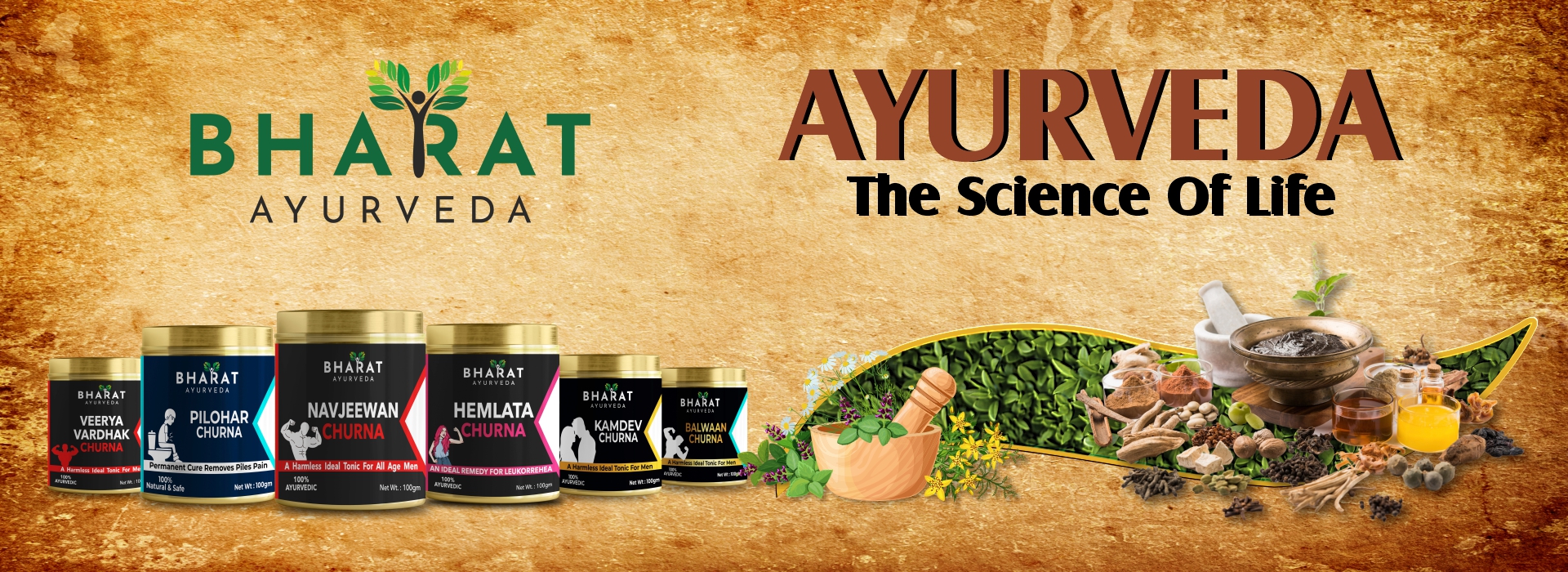

Introduction :
- “Ayurveda” is an ancient healing system and its roots originated in India more than 5,000 years ago. It is taken as the Upaveda of Atharvaveda (One among the four important Indian Vedas).
- The word Ayurveda is a combination of two words: “Ayur” means Life, “Veda” means Knowledge, Science, Wisdom. It called a “Science of Life”. More than a system of treating disease, this is a science of life & basic principles of Ayurveda.
- It gives a body of wisdom designed to help people stay healthy while realizing their full human potential guidelines on their ideal daily and seasonal routines, diet, behavior and the proper use of our senses, Ayurveda reminds us that health is the balanced and dynamic integration between our environment, body, mind, and spirit
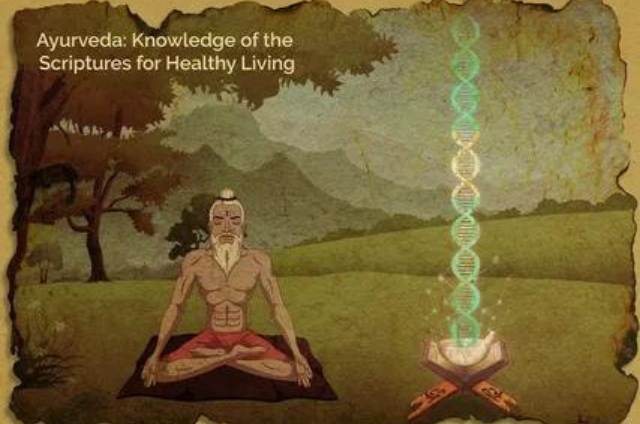

History of Ayurveda
Indra, in turn, taught Ayurveda to a group of assembled sages, who then passed down different aspects of this knowledge to their students. According to history, Ayurveda was first described in text form by Agnivesha, Book named “Agnivesh tantra” later on this book redacted by Charaka, and became known as the Charaka Samhita. Second early text of Ayurveda is the “Sushruta Samhita” which was compiled by Sushrut, the primary pupil of lord Dhanvantri, sometime around 1000 BC. “Maharishi Sushruta” is known as the Father of Shalya Tantra (Surgery).
The Eight Branches of Ayurveda (Principles of Ayurveda)
- Kayacikitsa (Internal Medicine)- General medicine, medicine for the wellness and treatment
- Kaumara-bhṛtya (Pediatrics)- The treatment of children, Pediatrics
- Shalyatantra (Surgery)- Surgical techniques and the extraction of foreign objects.
- Shalakyatantra (Ophthalmology & ENT)- Treatment of ailments affecting ears, eyes, nose, mouth, etc. (“ENT”)
- Bhutavidya- Psychiatry- Main deals with the Psychiatry problem.
- Agadatantra- toxicology –
- Rasayanatantra (Geriatrics) -Rejuvenation and tonics for increasing lifespan, intellect and strength
- Vajikaraṇatantra (Aphrodisiac)- Aphrodisiacs and treatments for sexual diseases, enhancement of sexual pleasure, infertility, etc.
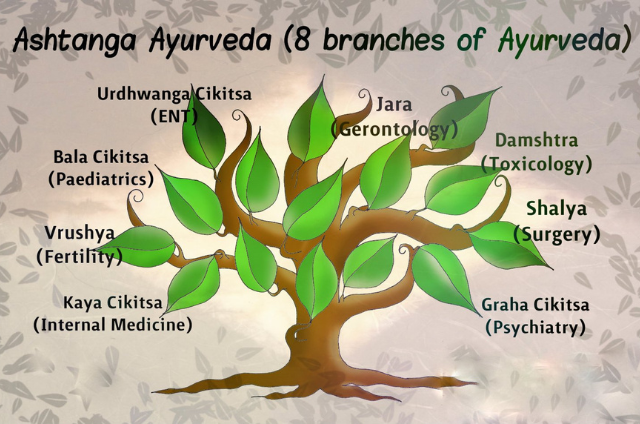

Objective of Ayurveda
SWASTHASYA SYASTHYA RAKSHANAM, AATURASHCHA VIKAR PRASHAMANAM”
“Preservation to the health of the healthy person and treating ailments with different methods of ayurvedic treatment mentioned in Ayurveda”.
Objective of Ayurveda
Health is defined as the state of Balance of functional humor, metabolic fires, tissues, and excretions with a pleasant soul, senses, and mind
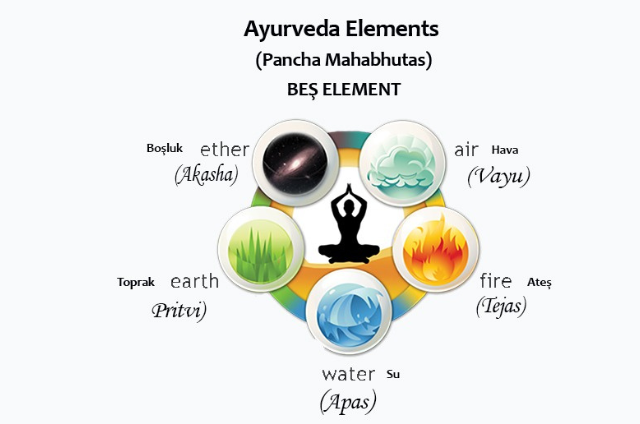
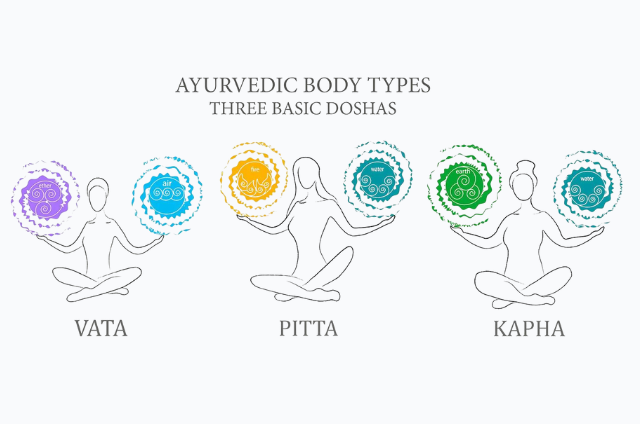
“Tri-dosha Theory”- The central concept of Ayurvedic medicine is the theory that health exists when there is a balance between three fundamental bodily senses of humor or tri doshas called Vata, Pitta, and Kapha.
Every person contains all three doshas. However, the proportion varies according to the person, and usually, one or two Doshas are predominant. Within each person, the Doshas are regularly interacting with each other and with the Doshas in all of nature.
This explains why a human can have much in similar but also have an endless variety of individual characteristics in the way they behave and respond to their environment.
In Ayurvedic ideology, the five elements associate in pairs to form three dynamic strengths or synergies called “doshas”. Dosha means “that which changes.” word taken from the root dus, which is correlative to the English prefix ‘days’, such as in dystrophy, dysfunction, etc. In this sense, dosha can be the witness as a fault, error, mistake, or infringement against the cosmic rhythm.
Functions of the Doshas
VATTA- is the air principle necessary to mobilize the function of the nervous system, brain functions, and sensory organs. And Vatta’s Main functions are Movement Breathing Natural Urges, Transformation of the tissues, Motor functions, Sensory functions, Secretions, Excretions, Fear, Emptiness, Anxiety, Thoughts, Nerve impulses
PITA- is the fire principle that uses bile to direct digestion & hence metabolism into the venous system. And Pitta’s Main functions are Body heat, Temperature, Digestion, Perception, Understanding, Hunger, Thirst Intelligence, Anger Hate, Jealousy
KAPHA- is the water principle that relates to mucous and lubrication and the carrier of nutrients into the arterial system. And Kapha’s Main functions are Stability Energy, Lubrication Forgiveness Greed Attachment Accumulation, Holding Possessiveness
The Doshas are continually moving in dynamic balance, one with the others. Doshas are required for life to come into existence. In Ayurveda, dosha is also known as the organizational principles of Ayurveda as every living thing in nature is characterized by the dosha.
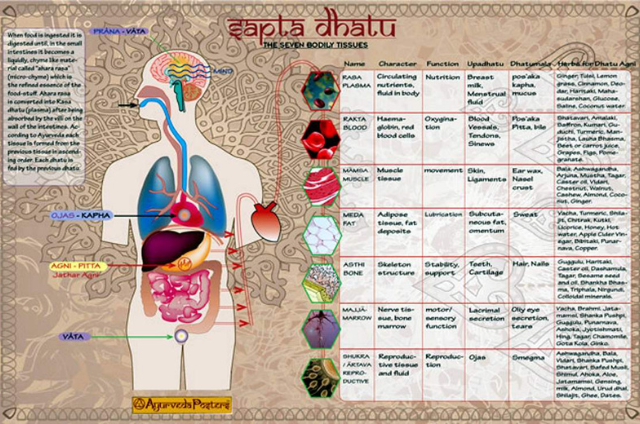
Sapta Dhatu – Seven Body Tissues
RASA – Final Metabolic Juice and Plasma (Digestive System)
RAKTA- Blood (Blood Circulatory System)
MAMSA– Muscles and Tendons (Muscular System)
MEDA- Fat
ASTHI – Bone (Skeleton)
MAJJA- Bone Marrow
SHUKRA- Semen Fluid (Reproductive System)
Note: In female one extra dhatu (Body Tissue) which is called “AARTAV” menstrual fluid.
Agni- Digestive Fire
Agni in Sanskrit means fire and is used to describe all metabolic functions in our body.
“A defective fire leads to improper functioning of the tissues which in turn, creates Ama in the gastrointestinal tract and leading to the poor synthesis of tissues.”
Types Of Agni (principles of Ayurveda): According To The function and site of action AGNI HAS BEEN DIVIDED INTO 13 TYPES ACCORDING TO THE FUNCTION AND SITE OF ACTION:
Jatharagni – One Agni present in the stomach and duodenum.
Bhutagni – Five Agni from five basic elements.
Dhatwagni – Seven Agni present, one in each of the seven dhatus-tissues
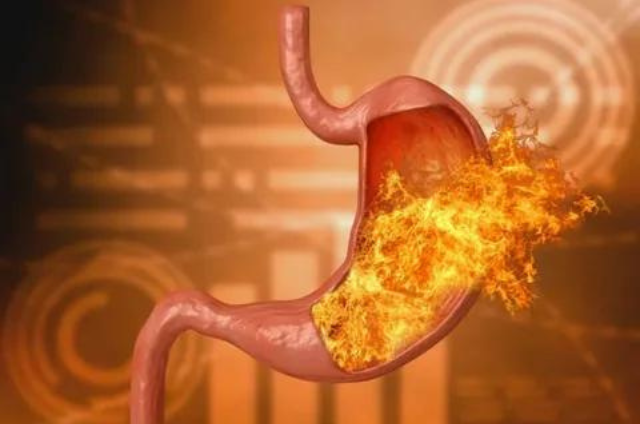

Sapta Dhatu – Seven Body Tissues
RASA – Final Metabolic Juice and Plasma (Digestive System)
RAKTA- Blood (Blood Circulatory System)
MAMSA– Muscles and Tendons (Muscular System)
MEDA- Fat
ASTHI – Bone (Skeleton)
MAJJA- Bone Marrow
SHUKRA- Semen Fluid (Reproductive System)
Note: In female one extra dhatu (Body Tissue) which is called “AARTAV” menstrual fluid.
What is PRAKRUTI (Consistency)
According to Ayurveda, Prakriti or the distinctive personality of an individual is driven by a combination of the Tridoshas – Vata, Pitta, and Kapha.
These three doshas rule a person’s health, diseases, a cure for any illness, etc. It is the blend of these three doshas that makes a person different and unique from others.
Concept of Prakruti :-
- According to Ayurveda, the basic constitution is decided at the time of conception by women. This constitution is named Prakruti.
- The name Prakruti is a Sanskrit word that means “nature,” creativity,” or “the first creation.” One of the most important concepts of
Ayurveda is that one’s basic constitution is established throughout his/her lifetime. - The mixture of Vata, Pitta, and Kapha that was present in the person at the time of conception is sustained throughout his lifetime.
As per the Ayurveda text following are the factors, which determine the Prakriti of the fetus:
- Time and season during the conception.
- Doshic dominance in the uterus.
- The condition of the sperm and ovum.
- Maternal food and lifestyle.
Tryo Stambh (Three Pillers) of Ayurveda
- Food (Diet)
- Sleep (Mental Wellness), Nidra
- Proper Management of Sexual Energy
Apart from above three main Piller, LifeStyle also play an important role for a healthy life ( Seasonal regimen (Ritu Charya) and daily regimen (Din Charya), Biological Clock
Role of Ayurveda for Wellness
- If one follows the basic principles of Ayurveda which includes diet & lifestyle, biological clock.
- A good sleep pattern according to one’s Prakriti and takes some herbs & herbal supplement according to his / her lifestyle, body type and season than can live a healthy and disease-free life.
- Due to present-day diet, lifestyle, stress we are not able to follow above-said things strictly and five sensory organs ( tongue-: taste ), Eyes: overutilization, Ear- Noise pollution & high sounds, Nose- Air pollution, a different type of chemicals, Skin- Touch, Chemical Products, Surgeries.
- Due to the above things, we invite different diseases. Ayurveda has so many traditional herbs, herbal mineral combinations, and classical ayurvedic medicine to treat and manage these disorders. These herbal formulation references are mentioned in ayurvedic books written by different ayurvedic scholars like Maharishi Charak, Maharishi Susrut, Maharishi Vaghbhat, and many others.
Ways of treatment in Ayurveda
- Ayurvedic Medicine (Pacification)
- Herbs, Herbs Juices, Herb Powder, Herbal Extract Capsule (Satav), Syrup, Kwath, Arisht, Ashav, Pishti, Bhasam, Kshar, Vatti, Ras Aushadhi, Ghrit, Lehas.

Ayurveda Surgery (Kshar Sutra For piles & fistula)
Modern surgery is also gifted to the world by the renowned Ayurveda guru maharishi sushrut who is a well-known surgeon of ancient time and who is even doing successful plastic surgery like rhinoplasty, organ transplant, eye surgeries without anesthesia & antibiotics.
Myths on Ayurveda medicine
Slow Healing- Ayurveda medicine working on root cause on different parameter and
secondly patient comes with chronic illness that’s take some time but heals properly without any side effects.
Ayurvedic Medicine Contains Heavy Metal & Poisonous substances
The production unit is also in compliance with USFDA regulations & guidelines to meet international standards for Ayurvedic Thirdparty Manufacturing Company under private labelling in India and Aboard. Production facility having the capacity to produce one million capsule and 10000 finish bottles of herbal oil & syrup per day for third party manufacturing of ayurvedic products under private labeling. We also have adequate repository capabilities for stocking raw herbs for our ayurvedic production unit in India. Our cutting edge facilities and trained manpower ensure our capacity in handling the requirements of our customers in a satisfactory manner for Ayurvedic Third-party Manufacturing Companies and Third Party Manufacturing of Ayurvedic Products.

